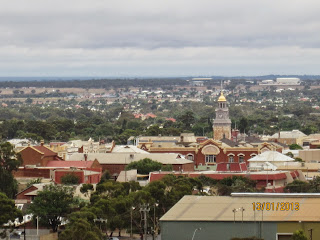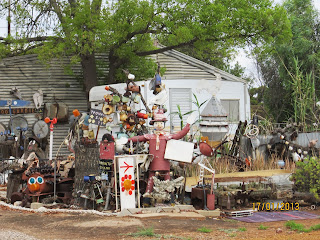I loved Kalgoorlie!
I think it’s all the history that is everywhere you look, the main street,
Hannan Street is simply superb, just one ornate building after another for two
large blocks, all with overhanging balconies on extra wide footpaths. Given most of the buildings were constructed
over 100 years ago when the average citizen was still living in basic tents and
canvas houses, you can just sense the wealth that these buildings represented. Apparently there were originally 63 pubs and many
are still standing. The population at its
gold mining peak was about 30,000, which is pretty close to the current
population.
 |
Overlooking Kalgoorlie. Town Hall clock tower is painted with
gold leaf. |
Most of the dozens
of individual mines were amalgamated in the 1980’s in a process that was
commenced by Alan Bond. Thirty years
later, they are all owned by one parent company and all the separate mines are
now one enormous mine, known as the ‘Superpit’.
There is a large viewing area overlooking the Superpit and I found myself
mesmerised by the tiny yellow specks in the pit moving backwards and
forwards. They were actually huge
earthmoving trucks. Not sure why, as I’m
not overly interested in mining. I think
it was just the sheer scale of the pit.
I’m not sure if it’s smaller or larger than the pit we saw at Tom Price,
but both were impressive. You can take a tour down into the pit and into
the gold processing areas, but I knew there’d be a riot if I even suggested
another mine tour. Fortunately, it was
quite expensive ($70 adult, $40 child), so I didn’t mind either. ‘Seen
one mine, seen ‘em all’ has even overtaken me!
 |
| The massive 'superpit' |
We did visit on
another day and see an actual blast take place, which, even though it was in
the distance, was quite exciting. Just
like in the movies, you can see the ground lift up when the explosives first
went off, rubble falling down the sides of the pit and then a huge cloud of
dust.
 |
| You can just make out the mine vehicles top centre, setting explosives |
 |
| The blast |
The family didn’t
escape a visit to the local museum which was a branch of the Western Australian
museum (there are branches in Perth, Geraldton, Fremantle and Albany). I thought I’d encounter some resistance to
stepping foot inside another museum, but they all followed without a
whimper! Maybe they knew it was
pointless to object. But seriously, why
visit such a fascinating town and not learn all you can about it? That’s my perspective anyway. In addition, it was only a gold coin donation
entry – bargain!
 |
| Inside a mine scooper. |
 |
| Furniture made from explosive boxes |
 |
| Main headframe, now the entrance to the museum |
 |
| Bicycle made entirely of wood. |
We had bizarre
weather during our stay in Kalgoorlie.
The whole country has been in the grip of a heat wave, with uncontrolled
fires everywhere and we’ve been experiencing 40+ days since Christmas. Then Cyclone Narelle developed off the coast
of Exmouth and turned into a rain depression reaching as far as Kalgoorlie, so
suddenly the temperature dropped and the skies opened. Our first visit to the museum had us in
jeans, hoodies and scarves. The second
visit had us hankering after the air-conditioning. Ah ha, maybe that’s why the family was happy
to visit a second time!
 |
| Kalgoorlie sunset |
Other interesting tidbits
about Kalgoorlie is that Howard Hoover, 31st President of the US,
worked as a mine engineer and later as mine manager in the area between 1897
and 1907 and later was involved as an investor in mines in Broken Hill. He became US President in 1929.
 |
| Coolgardie court house, 40km from Kalgoorlie and location of the original gold strike. |
A second
interesting tidbit, but once again, not taught as part of Australian history,
is that the Kalgoorlie goldfields is responsible for the ultimate Federation of
Australia.
When the separate
colonies were discussing Federation to become one country rather than separate
colonies, Western Australia was suspicious of the Eastern colonies and feared
it would lose the benefit of its mineral resources to the other colonies and
refused to conduct a referendum regarding Federation. Without the agreement of all colonies to
conduct a referendum, Federation was not feasible.
Around this same
time, the goldfields wanted to form a separate colony called ‘Auralia’. They wrote to Queen Victoria to make this request. The Queen wrote back to the Premier
of the Western Australia colony advising receipt of the request and that she would grant the request unless WA agreed to conduct the referendum on Federation. Basically, the WA government had no choice but to participate or risk losing this resource rich part of the WA colony. On 31 July 1900 Western Australia became the final Australian colony to vote for Federation. An overwhelming majority of voters were in favour of joining the eastern states to become the Commonwealth of Australia on 1 January 1901. The desire of
the goldfields to form ‘Auralia’ therefore led to the formation of Australia as
we know it. A fact most Australians
would be completely unaware of.
 |
| An unusual front garden in Coolgardie WA |
 |
A gold miners hut - lived in until 1971! Directly opposite is an open cut gold mine
discovered in the 1990's. |
 |
| Rear view of the miners hut. The whole structure is from reused and scavenged materials. |
 |
| Photo of the gold miner, Jim Carins, sitting outside the hut. |

Kalgoorlie is also
the location of our only car trouble in almost two years and 70,000 km of
travelling. Larry had noticed the battery wasn’t holding its usual charge the
day before we arrived in ‘Kal’ (as the locals call it), but we were able to
start and drive into first Coolgardie (38km from Kalgoorlie) and then into
Kalgoorlie itself. Just as we sighted
the 24 hour stopping area on the western outskirts of town, we moved into the
right lane to turn right across the highway.
Then the windshield wipers slowed right down, then the indicators
wouldn’t work, then we lost power steering and the whole car just rolled to a
gentle stop. No sooner had Larry got out
of the car (in the rain) than a stranger pulled up to help, and then another
stopped. One of them had a tow ball so they unhitched our van, attached it to their vehicle and drove it across the
highway to the stopping area. The other
fellow and Larry then pushed the Landcruiser off to the side of the road. Meanwhile I’m on the phone to the RACQ but
due to the rain, it’d be at least another 90 minutes before roadside assistance
was available. The stranger then drove
home, found a snatch strap, came back, attached our car and towed it to where
the van was. What a fabulous
introduction to the town!
Long and short of
it was that the alternator had died, and cooked a 3 month old battery at the
same time. RACQ then towed us to a
caravan park and arranged a car hire for us.
In the end, we were in the van park 4 days, which was quite a treat,
even though it rained for two days, but in the end I could get all the washing
done (we have a washing machine in the van, but need access to water) and the
girls got to swim in the pool when it turned warm again. And it did!
Back up to 40C.
We actually already
had the Landcruiser booked in at Toyota for a service which was quoted around
$1000 (seems to be the average service price we’ve noticed!), so we then had to
fork out another $500 for the alternator.
Fortunately, the battery survived. Still, as I said earlier, it’s the
first mechanical issue we’ve had towing the van and driving in some dodgy, isolated
areas, so we are not complaining.
My only regret is
that due to the wet weather, many of the surrounding roads were closed or
impassable as there are a number of old mining towns, now uninhabited, that
would have been worth exploring. Next
time!
 |
| Just south of Kalgoorlie we came across a kettle/coffee cup tree and added our own cup. |
Travellers Tip: Try to avoid visiting in the middle of summer. If you are interested in the architecture,
you can do a self-guided audio tour for $10.
There is a $50 deposit for the headset. WA Museum is gold coin donation
and excellent value. Oasis Recreation
Park has a great pool and a couple of water slides. Coles, Woolies, 24hr IGA. Fuel discounts
available. 24 hr free camp on western entrance to town and you can also free
camp at Douglas Reserve, approx 12 km towards Perth. Caravan Parks $50+ for family
of 4. All cabin accommodation is booked
out by miners.





